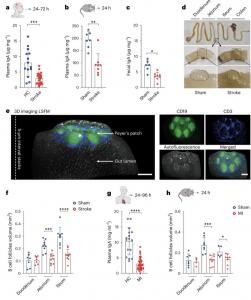A recent stroke or heart attack significantly weakens a person’s immune defenses, making them highly susceptible to serious infections. This vulnerability has puzzled researchers until now. A new study has shed light on the underlying cause and offers a promising therapeutic approach (Figure 1).

Figure 1: Ischemic stroke and MI reduce plasma IgA levels and B cell follicle volumes in PP: a, Concentrations of plasma IgA in patients with stroke and in healthy controls measured by ELISA (n = 14−23 per group, P = 0.0002). b,c, Concentrations of plasma IgA and fecal IgA in sham and stroke mice measured by ELISA (n = 6−8 per group, **P = 0.037, *P = 0.0053). d, Macroscopic overview of the mouse GI tract with the demarcation of PP 1 d after sham surgery or stroke. e, Fluorescence images after 3D reconstruction of stained PP showing the position of PP in the small intestine that were whole-mount stained with anti-CD19 (green) and anti-CD3 (blue) fluorescent antibodies before LSFM (left). Fluorescence single−channel images are shown (right); scale bar, 500 μm. f, Deep-learning-based automated analysis of B cell follicle volume in PP from duodenum, jejunum and ileum 1 d after stroke or sham (n = 7−11 PP per intestinal segment, 4−6 mice per group, sham versus stroke duodenum non-significant P > 0.9999, ***P = 0.0003, ****P < 0.0001). g, Concentrations of plasma IgA in patients with MI and healthy controls measured by ELISA (n = 16−39 per group, ****P < 0.0001). h, Deep-learning-based quantification of B cell follicle volume in PP of the duodenum, jejunum and ileum 1 d after sham or myocardial infarction (n = 4−9 PP per intestinal segment, 4−5 mice per group, sham versus MI non-significant P = 0.7879, ***P = 0.0002, *P = 0.0451). Data are mean ± s.d.; statistical analyses were performed by two-tailed Mann−Whitney U-test. All mouse data were combined from at least three independent experiments. HC, healthy control.
The study revealed a dramatic decrease in IgA antibodies, a key weapon in the fight against infections, in patients within 1-3 days of experiencing a stroke or heart attack. These antibodies are produced by specialized immune cells called plasma cells.
Researchers used disease models in mice to pinpoint the culprit behind the antibody loss. They discovered that neutrophil extracellular traps (NETs), DNA fibers released by neutrophils (another immune cell type), play a critical role in this process. Following a stroke or heart attack, highly activated neutrophils release large quantities of NETs into the bloodstream. These NETs can directly destroy plasma cells in the intestine, hindering IgA production.
The negative impact of NETs extends even further. They also contribute to the formation of numerous tiny blood clots in the vessels supplying oxygen and nutrients to the intestinal plasma cells. This starvation ultimately leads to the death of these vital immune cells, further crippling IgA antibody production.
With the cause of the immune dysfunction identified, researchers were able to explore potential treatment strategies. They found that either destroying NETs with the enzyme DNase or preventing their release with a novel agent effectively preserved immune function in the mouse model. DNase treatment has also shown promise in early clinical studies.
This breakthrough research unveils the previously unknown mechanism behind increased infection risk after stroke or heart attack. The potential of DNase therapy, or similar approaches that target NETs, offers a promising avenue to bolster immune defenses in these vulnerable patients. This could significantly reduce the risk of secondary infections and potentially save lives.
Journal article: Tuz, A. A., et al. 2024. Stroke and myocardial infarction induce neutrophil extracellular trap release disrupting lymphoid organ structure and immunoglobulin secretion. Nature Cardiovascular Research.
Summary by Stefan Botha










